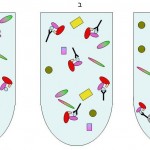Introduction
 One of the most common types of experiment submitted for analysis in the Proteomics Core is the Co-IP experiment. An antibody against endogenous or tagged protein is used to pull down a protein of interest. The goal of the experiment is to see what comes down with that protein, and is a potential interactor. Often Co-IPs will be compared across different treatments or conditions.
One of the most common types of experiment submitted for analysis in the Proteomics Core is the Co-IP experiment. An antibody against endogenous or tagged protein is used to pull down a protein of interest. The goal of the experiment is to see what comes down with that protein, and is a potential interactor. Often Co-IPs will be compared across different treatments or conditions.
Performing a Co-IP experiment with the core
We offer a qualitative or quantitative label-free complex mixture comparison for Co-IP samples. These methods use label-free or TMT quantification of proteomics datasets to compare an IP of interest to a control IP.
Sample Submission
IP and Co-IP samples can be submitted a number of ways, depending on your samples:
- On-bead (magnetic beads preferred but not required)
- good if difficult to elute your proteins off the beads
- Eluted off the beads
- this reduces contamination from the protein being used to pull down, typically IgG or strpetavidin
- In-gel
- good if you want to isolate a specific protein of interest.
We run the samples on the mass spectrometer and then analyze them. Identification of proteins is performed across all samples, to give consistent resolution of protein grouping / isoform ambiguity etc. We use a comparison of the peptide peak intensities for each protein between samples to provide an overview of the relative amount of each protein present. This allows background proteins present in control to be discounted, highlighting interesting candidate proteins for further study.
This method is cheap ($204 per sample for Lumos, $82/sample for QExactive HF) and simple. No labeling is required. It works well for experiments where you are looking for presence/absence or large fold changes in protein abundance between samples. It cannot provide accurate quantitative ratios for weaker proteins in a sample, which are observed with only a few peptides.
We have delivered useful results to a large number of researchers with this workflow. It is far cheaper, and outperforms, cutting out unique bands from a resolved gel, and submitting them for individual protein ID.